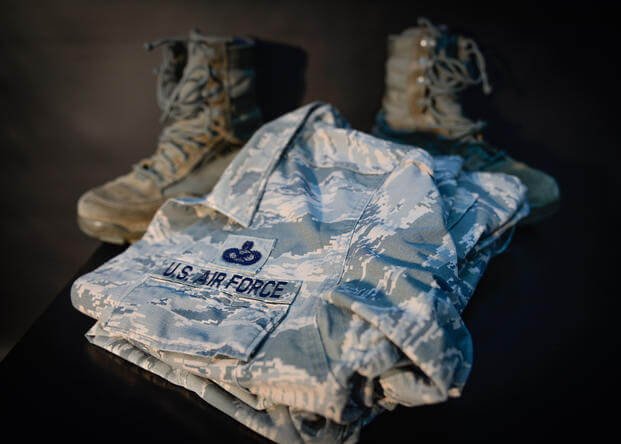No-Salute Zones, Watch Caps, Gym Bags: Air Force Summarizes New Policies Following Raft of Changes

The Air Force has republished its dress and personal appearance instruction to account for a wide range of policy updates and changes made in recent years so airmen can know whether they’re following the rules.
In addition to the updated instruction, the service also released graphics that detail the new policies for hair and mustache length, neck tattoos, nail polish color and eyelash extensions.
“We’ve reviewed the policy in whole to make certain we are communicating standards clearly, making it an easier tool for commanders, supervisors, airmen and Guardians,” Lt. Gen. Caroline Miller, deputy chief of staff for manpower, personnel and services, said in a Thursday press release. “Revisions were made over a number of years, but we felt the need to revisit the entire document to remove redundancies [and]out-of-date information and decrease subjectivity.”
Some of the past policy changes announced last year that are now codified in the new Air Force instruction include:
- Authorize installation commanders to designate Child Development Centers as a “no-hat, no-salute zone” in which salutes are not required when either person is carrying children.
- Allow service members to wear a cold-weather headband in addition to existing cold weather accessories, which include scarves, earmuffs, watch caps and gloves.
- Grant a total of four badges on the Operational Camouflage Pattern (OCP) uniform above the Air Force tape, up from the currently authorized two badges.
- Add an Operational Camouflage Pattern patrol cap or tactical cap while in the Flight Duty Uniform (FDU).
- Allow a “small logo” on purses and handbags not exceeding one inch in diameter.
- Add olive drab green as an authorized backpack color — in addition to the already permitted black, brown, gray and dark blue colors — to wear with any uniform combination.
- Allow a logo of any size on gym bags.
- Expand the current regulation to allow cold-weather parkas to be commercially purchased, with certain exceptions. Parkas must be OCP pattern or coyote brown and have name tapes, service tape, rank and patches worn in the same authorized configuration.
- Allow for Friday morale shirts with larger logos up to five inches in diameter, but the shirts must be coyote brown.
- Authorize the wear of “heritage-like” morale patches on the Flight Duty Uniform.
The newly published uniform guidelines also require wing commander approval for religious regalia wear during events, allow female wear of mess dress trousers or slacks, wear of caps for baldness or hair loss due to medical conditions, and beverage consumption while walking in uniform.
Last year, the Air Force and Space Force began allowing tattoos on the neck and hands, a policy change aimed at bringing younger talent into the ranks.
Under that policy, airmen and Guardians are allowed to have one tattoo on each hand and one tattoo on the back of the neck; they cannot exceed one inch or portray obscene, racist or violent symbols. Previously, the services allowed only ring tattoos limited to a single band.
In recent years, the Department of the Air Force has amended many quality-of-life policies, including those for facial hair, amid a recruiting crisis and a recognition that some existing rules harm those of various religious beliefs, as well as certain minorities.
In 2022 that the department was floating the idea of a pilot program that would allow airmen and Guardians to grow beards.
The outward-facing group of service members whose mission is to represent the ideal airman to the American public, has started allowing those with shaving waivers to sport beards.
Grooming standards requiring a clean shave can disproportionately affect minority service members. Some get frequent ingrown hairs and skin irritations known as pseudofolliculitis barbae, or PFB. The condition is often found in curly-haired men and occurs in about 60% of African American men, according to studies by the American Osteopathic College of Dermatology.
Black service members have also reported that obtaining a shaving waiver has harmed their careers.
A survey conducted for a 2021 study for the journal Military Medicine showed that, of those who had received shaving waivers, 21.4% said it had a negative impact on their careers. In all, 63% of those who said it harmed their careers or created negative bias within their unit were Black.
Thursday’s announcement did not address any additional beard waivers outside of religious or medical accommodations.
“When it comes to standards, our airmen need the best guidance we can offer,” Chief Master Sergeant of the Air Force JoAnne Bass, who is set to retire this month, said in a press release. “These changes and updates to the publication are meant to clarify professional military appearance and uniform standards across the Air Force and empower all airmen to hold themselves, and others accountable.”



